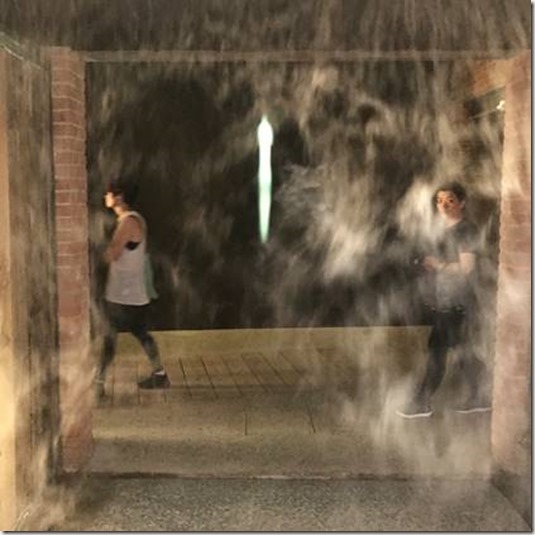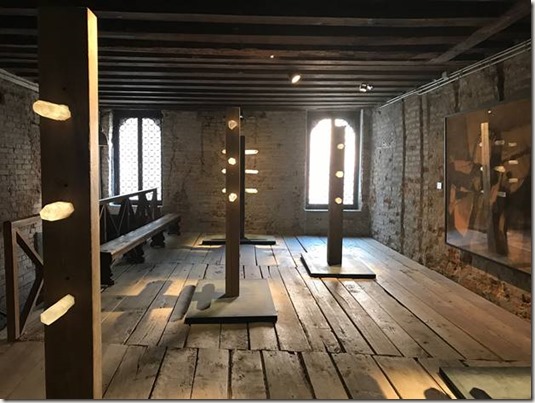[part of an ongoing series of reviews by Biennial Project Artists on their favorite things at the Venice Biennale 2017]
by Coral Woodbury, for The Biennial Project
“When you reach the end of what you should know, you will be at the beginning of what you should sense.”
- Kahlil Gibran
“When the body functions spontaneously, that is called instinct. When the soul functions spontaneously, that is called intuition.”
- Shree Rajneesh
Peter Greenaway's installation at Palazzo Fortuny during the 1993 Venice Biennale left such an impression on me that the one thing I knew heading to Venice was that I would return to the Palazzo. Even in Venice this is a unique space, embodying faded and decaying grandeur while preserving the home and collections of Mariano Fortuny, an early twentieth-century stage, fashion, and lighting designer. So the house is a stage set of sorts, and one an artist like Greenaway knew how to animate eerily.
As it turned out, I was in time for the sixth and last collaboration of Axel Vervoordt, Belgian antiquarian, art dealer, interior designer and curator, and Daniela Ferretti, Director of Palazzo Fortuny. Intuition was absolutely worth the 25 year wait.
|
 | |
The exhibition explores “how intuition has, in some form, shaped art across geographies, cultures and generations. It [brings] together historic, modern and contemporary works related to the concept of intuition, dreams, telepathy, paranormal fantasy, meditation, creative power, hypnosis and inspiration.” It showcases work by anonymous ancient artists to iconic surrealists and modernists to El Anatsui and Marina Abromovich. The resulting show probes questions about the creative impulse, the subconscious origin of art making. You come to sense that the four floors of art are brought together as a devotional study, a deep research into an inexplicable yet ultimately knowable mystery. Within the palace walls are volumes of thought about this thing that is beyond thought. This thing that cannot be expressed in words.
Beyond words, but Vervoordt fully articulates it in vision and experience. Entering on the ground floor, most raw of the spaces, you are first confronted with Neolithic menhirs, powerful in their monumental quiet. Then you turn, and you see they are paired with a large Basquiat. In a flash of comprehension you sense the connections between these disparate works before you could ever start to formulate words about them. The entire show is like this: a dynamic dialogue of works speaking to each other, and you enter into this dialogue. Seemingly unrelated works create a humming

energy. If you are quiet you can attune yourself to this vibration. Juxtapositions and connections unfold across time, across geography, across culture, but unite in exploring this one overarching theme that connects humanity across all of its separations.
As you move up to the piano nobile, a violin sound installation resonates through the historic interior, creating an enchanting environment. It is a dim space, almost too dim to read the labels, but illuminated by irregular pulses of soft light from great domed fixtures overhead. These lights brighten in response to lightning hitting anywhere in Italy, connecting this interior space to the outside world, and your experience to others’. From the darkness of this floor you move up into light, the blacks give way to whites where airy rooms are filled with the light of Venice and work enlivened by light. Soft shades of damaged frescoes meld with the colors of paper, felt, and
canvas. Up another floor the walls are the color of terra cotta and the work there has an earthiness to its form and materials. A participatory installation invites visitors to roll balls from lumps of clay, leaving behind an embodied meditative moment, amassing collectively on a giant oval table. Each level of the show contains and is an example of exquisitely sensitive creation. The sheer beauty of the works, independently and in harmony, set this show apart. There is a lot of brute and ugly art during the biennial, as there is brutality and ugliness in the world, but not here. The beauty is soothing and embracing; the silent conversations between the works, inspiring and exciting; the wholeness of the show is ethereal. Vervoordt’s final exhibition here cannot explain intuition, but it does engender a deep understanding of it, and a sparking of it in one’s own spirit.
https://intuition.art
Fortuny Palace info and tickets
Check out Coral’s beautiful work here: http://jcoral.com/